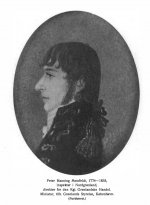Björn Bergenholtz
(former alias "Calalp")

Amendment due to slippery fingers …

francsii
● … in the invalid "Uria Francsii"
= the fairly unknown British military/naval Captain (in the Royal Navy) Frederick Franks (fl. 1844), who also could call himself; printmaker; painter (watercolourist) and draughtsman ... as earlier, Post No. #34.
Sorry for that misspelled first name! As anyone saw in the linked text, there´s (of course!) no extra, odd r, in his Christian name. My slip of finger!
PS. According to Laurent's British Museum link he was a k a Frederic Franks.
Thanks Laurent for pointing out the obvious!The British Museum has a page about a Captain Frederick Franks, albeit not with much info.
[Here], Uria francsii is a nomen nudum; but not in the Trans. Linn. Soc.: there, the footnoted reference to Sabine's description is technically enough to make the name available. Note that the Richmond Index dates both Trans. Linn. Soc. names (Sabine's and Leach's, thus) from 1819.
"[...], so wünschte ich ihn nach dem Freunde, dessen Gefälligkeit ich manche nordische Seltenheit verdanke, Uria Motzfeldi genannt."
"[...], then I wish it to be named Uria Motzfeldi, after the friend to whose kindness I owe more than one nordic rarity."
francsii
● … in the invalid "Uria Francsii"
= the fairly unknown British military/naval Captain (in the Royal Navy) Frederick Franks (fl. 1844), who also could call himself; printmaker; painter (watercolourist) and draughtsman ... as earlier, Post No. #34.
Sorry for that misspelled first name! As anyone saw in the linked text, there´s (of course!) no extra, odd r, in his Christian name. My slip of finger!
PS. According to Laurent's British Museum link he was a k a Frederic Franks.
Last edited:







